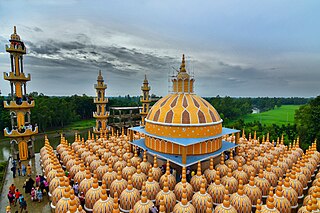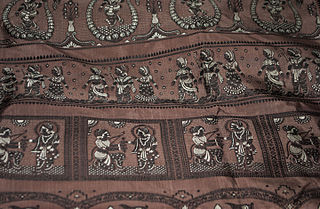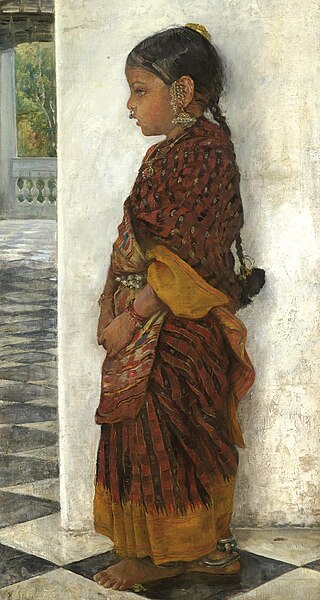| Part of a series on the |
| Culture of Bangladesh |
|---|
 |
The handloom industry in Tangail is one of the oldest cottage industries in West Bengal. This traditional saree is produced in Tangail district and is named after the place. [1]
| Part of a series on the |
| Culture of Bangladesh |
|---|
 |
The handloom industry in Tangail is one of the oldest cottage industries in West Bengal. This traditional saree is produced in Tangail district and is named after the place. [1]
The handloom industry in Tangail evolved during the last decades of the nineteenth century. The weavers of this Tangail cloth are the successors of the famous Muslin weavers. They were originally from Dhamrai and Chowhatta of Dhaka district and were invited to Tangail by the Jamidars (landlords) of Delduar, Santosh and Gharinda. The weavers made settlements in twenty-two adjacent villages in Tangail. At first they weaved only plain cloth. The Swadeshi movement called by Mahatma Gandhi in 1906 aimed to boycott cotton textiles from Lancashire, which inspired the use of local cotton cloths and the handloom industry in East Bengal (present-day Bangladesh) flourished at that time. During 1923–24 motifs and designs were introduced on saree. Jacquard looms were introduced during 1931–1932 for making sarees.[ citation needed ]
The handloom industry in Tangail is a cottage industry and the looms are mostly installed in households. 72% of the total installed looms have a unit size of five looms. Units with six to ten looms are 11% and units with eleven to twenty looms are 6% of the total. Units with twenty-one onward looms occupy 11% of the total and are considered small factories. However, a study done by the Ministry of Industries in 1982, shows that small factories have 20% of handlooms.[ citation needed ] In the year 1992, there were over 100,000 handlooms and 1,50000 weavers in Tangail, located in Sadar, Kalihati, Nagarpur, and Basail upazilas. In the year 2008 there were 37222 handlooms in 10000 small and big handloom factories and there were more than 70000 weavers working under the Basic Centres in several upazilas of Tangail. [2] A survey conducted in 2013 said there are 60,000 looms in Tangail. Of them, 8,305 are pit looms, 51,141 are Chittranjan looms and 892 are power looms.
Tangail handloom is popular all over the world for its uniqueness.[ citation needed ] The workers need to have special skills to weave and design Tangail sarees. The Basak community of Patrail Union of Tangail is a community of weavers who are still continuing the original making process of Tangail saree. The weavers sell the sarees in temporary bazaars that sit only twice a week in Bazitpur and Korotia. Traders come to these bazaars to purchase sarees.
Tangail Saree is in demand in many countries, like India, America, Japan, the Middle East, and some European countries. Each week Bangladesh exports around 50,000 pieces of sarees to India.[ citation needed ]
The handloom industry is in crisis because of the increase in the price of thread, yarn, dye and other raw materials and insufficient transportation and supply chain facilities. As a result, many weavers are leaving their profession and migrating. [2] [4]

Jamdani is a fine muslin textile produced for centuries in South Rupshi of Narayanganj district in Bangladesh on the bank of Shitalakhwa river.

Tangail is a district (zila) in the central region of Bangladesh. In 1969, Tangail district was created by Tangail Mohokuma from its 237 square kilometers of land and 3177 square kilometers of land acquired from Mymensingh district. It is the largest district of Dhaka division by area and second largest by population. The population of Tangail zila is about 4 million and its area is 3,414.28 square kilometres (1,318.26 sq mi). The main city of the district is Tangail. It is surrounded by Jamalpur District on the north, the Dhaka and Manikganj Districts on the south, Mymensingh and Gazipur on the east, and Sirajganj on the west.

Khadi, derived from khaddar, is a hand-spun and woven natural fibre cloth promoted by Mahatma Gandhi as swadeshi (self-sufficiency) for the freedom struggle of the Indian subcontinent, and the term is used throughout India, Pakistan and Bangladesh. The first piece of the hand-woven cloth was manufactured in the Sabarmati Ashram during 1917–18. The coarseness of the cloth led Gandhi to call it khadi. The cloth is made from cotton, but it may also include silk or wool, which are all spun into yarn on a charkha. It is a versatile fabric that remains cool in summer and warm in winter. To improve its appearance, khadi is sometimes starched to give it a stiffer feel. It is widely accepted in various fashion circles.

A Banarasi sari is a sari made in Varanasi, an ancient city which is also called Benares (Banaras). The saris are among the finest saris in India and are known for their gold and silver brocade or zari, fine silk and opulent embroidery. The saris are made of finely woven silk and are decorated with intricate designs, and, because of these engravings, are relatively heavy.
Balaramapuram is one of the panchayats that form the city of Thiruvananthapuram, the capital of Kerala, India. It is the most urbanized panchayat in Thiruvananthapuram.

Silk In India, about 97% of the raw mulberry silk is produced in the Indian states of Karnataka, Andhra Pradesh, Tamil Nadu and West Bengal. Mysore and North Bangalore, the upcoming site of a US$20 million "Silk City", contribute to a majority of silk production. Another emerging silk producer is Tamil Nadu in the place in where mulberry cultivation is concentrated in Salem, Erode and Dharmapuri districts. Hyderabad, Andhra Pradesh and Gobichettipalayam, Tamil Nadu were the first locations to have automated silk reeling units.

Madhupur is an upazila of Tangail District in the Division of Dhaka, Bangladesh.

A weavers' cottage was a type of house used by weavers for cloth production in the putting-out system sometimes known as the domestic system.
The textile industry in Salem, especially the handloom industry, is one of the most ancient cottage industries in Salem district of Tamil Nadu, India. Salem was one of the primary handloom centers of south India. Sari, dhoti and angavasthram are made out of silk yarn and cotton yarn. In the recent past, home furnishing items are also woven, mainly for export purposes. More than 75,000 handlooms are working and the total value of cloth produced per annum is estimated at Rs.5,000 crores

Baluchari Sari is a type of sari, a garment worn by women in the Indian states of West Bengal, Tripura and Assam and the country of Bangladesh. This particular type of sari originated in West Bengal and is known for depictions of mythological scenes on the anchal of the sari. It used to be produced in Murshidabad but presently Bishnupur and its surrounding areas of West Bengal are the only place where authentic Baluchari saris are produced. It takes approximately one week to produce one such sari. In 2011, the Baluchari Sari was granted the status of Geographical Indication for West Bengal in India.

Tant sari is a traditional Bengali sari, originating from the Bengal region in the eastern part and usually used by Bengali women. Tant sari are woven from cotton threads and distinguished by its lightness and transparency. It is considered to be the most comfortable sari for the hot and humid climate in the Indian subcontinent.

Pochampally sari or Pochampalli ikat is a saree made in Bhoodan Pochampally, Yadadri Bhuvanagiri district, Telangana State, India. They have traditional geometric patterns in "Paagadu Bandhu" (Ikat) style of dyeing. The intricate geometric designs find their way into sarees and dress materials. The Indian government's official airplane company, Air India, has its cabin crew wear specially designed Pochampally silk sarees.
Kovai Cora cotton or Kovai Kora cotton is a type of cotton saree made in the Coimbatore region in Tamil Nadu, India. It has been recognized as a Geographical indication by the Government of India in 2014–15.

The history of the textile arts of Bangladesh dates back to the 1st century AD. According to the archaeological excavations, Bangladesh was once famous for its artistic textile production throughout the world. Over the years, several types of textiles evolved in the country, mostly by the indigenous handloom manufacturers.
William Horrocks, a cotton manufacturer of Stockport built an early power loom in 1803, based on the principles of Cartwright but including some significant improvements to cloth take up and in 1813 battening.

Handloom saris are a traditional textile art of Bangladesh and India. The production of handloom saris is important for economic development in rural India.

Habaspuri is a cotton-based traditional handloom textiles of Odisha, India. Habaspuri sari is a major product of this textile. The Bhulia weavers of Chicheguda, Kalahandi district, Odisha are originally attributed for weaving of the Habaspuri fabric. For its uniqueness in weaving, design and production, it has been identified as one of the 14 Geographical Indications of Odisha.

Tangail saree is a traditional handwoven saree (Sari) of West Bengal. It is produced in Purba Bardhaman & Nadia districts of West Bengal. These handlooms are famous for the novelty of saree designs, hand-woven booties, use of natural fibers in the weave and saree fineness of the fabric. In 2024, Tangail Saree was recognized as a Registered Geographical indication under the title Tangail Saree of Bengal and Banglar Tangail Saree in Bengali language.

Tangail saree is a traditional handwoven saree of Bangladesh. It originated in the Tangail district of the country. A completely different kind of saree is produced in the Purba Bardhaman and Nadia districts of West Bengal. It is a simplified Jamdani textile which is a hybrid of Shantipuri saree with saree desighns and handloom techniques of Tangail. At one level, it is a gross simplification of the famed Jamdani technique. This is completely different from the Tangail sari of Bangladesh.

Shantipur Handloom Industry, also known Shantipur Handloom Cluster, is a handloom weaving industry in Nadia district of West Bengal. It is one of the foremost handloom centers of India. This handloom industry is world famous for the production of cotton Sari (saree). The two main centers of this industrial zone are Shantipur and Phulia. Shantipur has an old reputation for cotton sarees, known as Shantipuri sarees, and Phulia is well known for Tangail-Jamdani sarees.